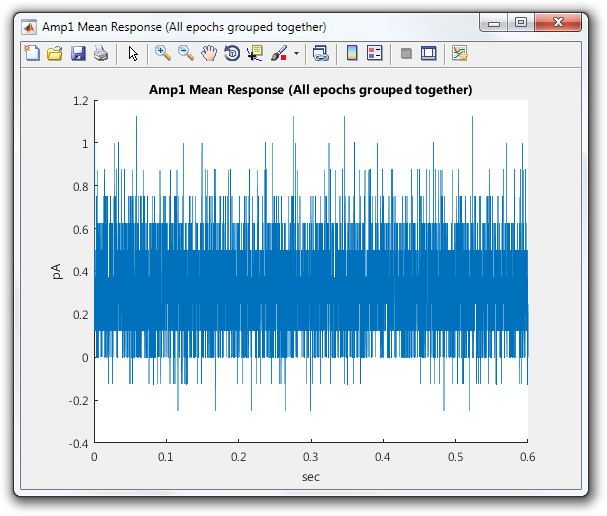Show Figure Handlers in a Protocol
A FigureHandler manages a figure displayed by a protocol. It creates the figure controls (typically a plot) and updates the figure as each epoch completes. A FigureHandler is generally used to graphically present data and perform online analysis.
This tutorial shows how to show FigureHandlers in a protocol.
Step 1: Open or create a protocol
Open or recreate the "Demo" protocol so you have something to work with.
classdef Demo < symphonyui.core.Protocol
properties
amp = 'Amp' % Output amplifier
preTime = 50 % Pulse leading duration (ms)
stimTime = 500 % Pulse duration (ms)
tailTime = 50 % Pulse trailing duration (ms)
pulseAmplitude = 100 % Pulse amplitude (mV)
numberOfAverages = 5 % Number of epochs
end
methods
function prepareEpoch(obj, epoch)
[email protected](obj, epoch);
gen = symphonyui.builtin.stimuli.PulseGenerator();
gen.preTime = obj.preTime;
gen.stimTime = obj.stimTime;
gen.tailTime = obj.tailTime;
gen.amplitude = obj.pulseAmplitude;
gen.mean = 0;
gen.sampleRate = obj.sampleRate;
gen.units = 'mV';
stimulus = gen.generate();
device = obj.rig.getDevice(obj.amp);
epoch.addStimulus(device, stimulus);
epoch.addResponse(device);
end
function tf = shouldContinuePreparingEpochs(obj)
tf = obj.numEpochsPrepared < obj.numberOfAverages;
end
function tf = shouldContinueRun(obj)
tf = obj.numEpochsCompleted < obj.numberOfAverages;
end
end
end
Step 2: Override prepareRun
FigureHandlers are generally shown in the prepareRun() method which is executed when a protocol starts but before any epochs have run.
Override the prepareRun() method in the "Demo" protocol.
classdef Demo < symphonyui.core.Protocol
properties
amp = 'Amp' % Output amplifier
preTime = 50 % Pulse leading duration (ms)
stimTime = 500 % Pulse duration (ms)
tailTime = 50 % Pulse trailing duration (ms)
pulseAmplitude = 100 % Pulse amplitude (mV)
numberOfAverages = 5 % Number of epochs
end
methods
function prepareRun(obj)
[email protected](obj);
end
function prepareEpoch(obj, epoch)
[email protected](obj, epoch);
gen = symphonyui.builtin.stimuli.PulseGenerator();
gen.preTime = obj.preTime;
gen.stimTime = obj.stimTime;
gen.tailTime = obj.tailTime;
gen.amplitude = obj.pulseAmplitude;
gen.mean = 0;
gen.sampleRate = obj.sampleRate;
gen.units = 'mV';
stimulus = gen.generate();
device = obj.rig.getDevice(obj.amp);
epoch.addStimulus(device, stimulus);
epoch.addResponse(device);
end
function tf = shouldContinuePreparingEpochs(obj)
tf = obj.numEpochsPrepared < obj.numberOfAverages;
end
function tf = shouldContinueRun(obj)
tf = obj.numEpochsCompleted < obj.numberOfAverages;
end
end
end
Note: Make sure you call the superclass method when you override prepareRun().
|
Step 3: Show figure handlers
Symphony comes with four built-in FigureHandler implementations:
symphonyui.builtin.figures.ResponseFigure- Plots the response of a specified device in the most recent epoch.symphonyui.builtin.figures.ResponseStatisticsFigure- Plots statistics calculated from the response of a specified device for each epoch run.symphonyui.builtin.figures.MeanResponseFigure- Plots the mean response of a specified device for all epochs run.symphonyui.builtin.figures.CustomFigure- Delegates to a specified callback function to handle creating and updating the controls of the figure.
Show a ResponseFigure in the "Demo" protocol by adding a line calling the showFigure() method and passing it the "Amp" device.
function prepareRun(obj)
[email protected](obj);
obj.showFigure('symphonyui.builtin.figures.ResponseFigure', obj.rig.getDevice(obj.amp));
end
Show a MeanResponseFigure in the "Demo" protocol by adding another line calling the showFigure() method and passing it the "Amp" device.
function prepareRun(obj)
[email protected](obj);
obj.showFigure('symphonyui.builtin.figures.ResponseFigure', obj.rig.getDevice(obj.amp));
obj.showFigure('symphonyui.builtin.figures.MeanResponseFigure', obj.rig.getDevice(obj.amp));
end
The "Demo" protocol now displays two figures when it is run. Each figure automatically updates when an epoch completes.

